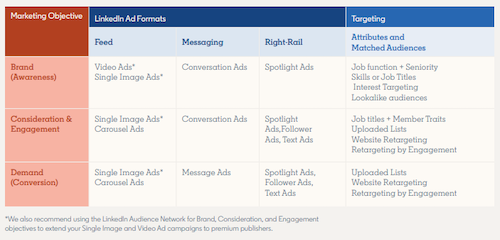How LinkedIn Tools Help Marketers Address the Full Funnel
Have you ever dropped a coin into one of those giant vats where it circles for a minute before disappearing through a hole at the bottom? You know, those hot tub-looking things they place in malls, airports, and stadiums? I guess they’re called hyperbolic funnels.
Anyway, a few thoughts about those. First, getting people to part with their money for the mere joy of watching it vanish – what a concept! Second, that rolling coin is a pretty good representation of how B2B buyers generally move through the purchasing process. I know, I know – comparing a metaphorical funnel to an amusingly large one … how profound. But it’s about the coin:
At the top of the funnel (awareness), it doesn’t look like much progress is being made, yet the coin covers much ground. Rarely does its initial path represent a perfect circle. It tends to meander up and down, at times moving away from the bottom. It’s as if the coin is deciding when, where, and how to truly commit to this contraption.
As the coin moves toward the middle (consideration), its circular path tightens up and it appears to pick up steam. It looks like the coin has officially decided to take the plunge.
As it descends toward the bottom of the funnel (demand), the coin circles even faster and its track becomes tighter yet. There’s no question where it’s going at this point. Still, some necessary circling must happen (work with sales, due diligence, negotiation, etc.) before it arrives at its destination.
Again, the coin represents the purchasing journey, not our marketing funnels. To give ourselves the best shot of being invited on that journey – or at least the ones we want to take part in (an account-based marketer may only be interested in newly minted nickels) – two things typically need to happen:
1. We need to show up early. According to Forrester’s 2020 report, “What B2B Buyers Crave,” B2B marketers tend to overly focus on product-based marketing. The problem with that approach is that buyers aren’t usually interested in product-based messages until later in their processes. Per the report: “Too many B2B marketers underestimate the importance of branding to their success, focusing instead on a product-based appeal to buyers.” Backing this assertion is a survey showing that B2B marketers who think long-term are 2x more likely to succeed.
By showing up early, marketers can earn buyers’ attention and trust while both are still very much earnable – before buyers move lower in the funnel and commit to their course.
2. We need to build trust by making buying less of a struggle. “As hard as it has become to sell in today’s world, it has become that much harder to buy,” says Gartner’s Brent Adamson. The keys here for marketers are to make sure every action facilitates clarity and progress, and nothing is harder than it needs to be.
Trust is the main driver of meaningful relationships. It’s why prospects convert to customers. When it comes to building trust via social media, LinkedIn ranks No. 1 for “least annoying ads,” “confidence in data,” “least deceptive content,” and “feel safe participating.”
Let’s look at some of the trust-building strategies and tactics you can use on LinkedIn to create a full-funnel experience that can attract the right people and facilitate a positive, memorable buying experience.
First, if you’re marketing to the full funnel, each campaign should have one of the following three marketing objectives:
- Awareness campaigns maximize your brand’s share of voice through impressions.
- Consideration campaigns encourage prospects to learn more about your organization.
- Conversion campaigns focus on lead generation and allow you to track campaign-initiated actions on your website.
Ideas to Help You Get Started with Awareness Campaigns
Effective ad formats for awareness-oriented campaigns typically include Video Ads, Single Image Ads, and Conversation Ads. In the awareness stage, you could:
Use a series of Video Ads to captivate your audience and bring awareness to a cause, an event, or a brand campaign. If you plan to use Video Ads, consider basing the next step on the viewer’s engagement. For example, you might retarget those who watched 25% or more of your Video Ad with a follow-up Video Ad or Single Image Ad to provide additional information and deepen engagement.
Use Single Image and Video Ads in tandem to bring visual stories to life. For instance, you could highlight interactive customer stories in testimonial form. At the same time, you could promote other relevant case study examples using a Single Image Ad.
Use Conversation Ads to deliver personalized stories at scale. You could also provide visual context about the subject of your message by including rich media in the body of your message.
Ideas to Help You Get Started with Consideration Campaigns
Effective ad formats for consideration-oriented campaigns typically include Single Image Ads, Carousel Ads, and Conversation Ads. In the consideration stage, you could:
Drive website visits by using a Single Image Ad in combination with a Conversation Ad, giving your audience multiple options for taking their next action. In terms of audience, you might consider retargeting those who visited high-intent pages on your website or downloaded a specific piece of content.
Drive engagement by combining a Video Ad with a Carousel Ad. The visual components incorporated could empower a richer story that does a fantastic job of illustrating your capabilities. This could serve as a great way to preview an event you’re trying to drive registrations for. You could even use the Carousel Ad to showcase your featured speakers.
Drive video views to increase reach and engagement with the visual story you need to tell. Consider retargeting audience members who watched some or all of a previous Video Ad. In fact, it’s generally a good idea to split your audience into two segments: those who watched less than half of your Video Ad and those who watched more than half. That way, you can vary the length of future ads based on behavior, which has been shown to increase engagement.
Ideas to Help You Get Started with Conversion Campaigns
Effective ad formats for conversion-oriented campaigns include Single Image Ads, Carousel Ads, Message Ads, and Lead Gen Forms. In the conversion stage, you could:
Generate leads by driving product demos, free trials, or event registrations. To do this, you might consider using a Single Image Ad and Message Ad together with a Lead Gen Form.
Convert website visitors by driving more high-intent conversion opportunities to your website, such as intent-indicating downloads or sales demos. When creating your conversion-oriented campaigns, don’t forget about the audience members who engaged with or downloaded your content in your earlier-stage campaigns.
Got all that? Here’s a high-level chart to help you piece everything together:
For more examples, ideas, and hot tips designed to help you get the right buyers to gladly roll into your marketing funnel, check out LinkedIn’s Brand and Demand Playbook.






